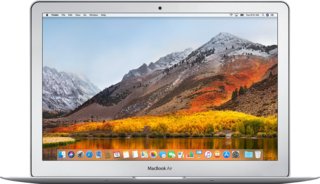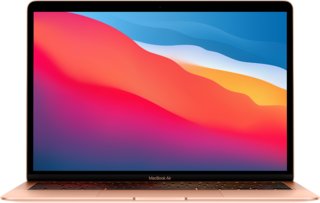Apple MacBook Air (2017) 13.3" Intel Core i5 128GB vs Apple MacBook Air (2020) 13.3" Apple M1
When comparing Apple's MacBook Air models, the 2017 version features a classic design and a 1.8GHz Intel Core i5 processor with 128GB storage, suitable for basic use. In contrast, the 2020 model presents a modern aesthetic with Apple's M1 chip and a larger 512GB SSD, resulting in improved speed, better multitasking capabilities, and smoother handling of demanding software.
Both models maintain Apple's renowned quality construction and intuitive interface. Nevertheless, the 2020 MacBook Air surpasses with quicker load times and enhanced battery longevity. If you prioritize top-notch performance along with generous storage capacity, it may merit your consideration. This evaluation can assist you in making a well-informed decision that precisely matches your requirements.
System and application performance
Performance in popular 3D games
Viewing angle, color accuracy...
Ports, webcam and other interfaces
Potential battery life
Materials, durability and portability
Design Comparison
Size Comparison
Apple MacBook Air (2017) vs. Apple MacBook Air (2020) Comparison
When it comes to improving user experience through design, the Apple MacBook Air (2017) and the Apple MacBook Air (2020) each bring unique qualities to cater to different user preferences. Let's explore how their design elements impact usability and aesthetics.
Ergonomics & Portability:
- The Apple MacBook Air (2020) is lighter at 2.8 pounds compared to the 3 pounds of the MacBook Air (2017), enhancing its portability for users who are frequently on the move.
- The MacBook Air (2020) features a thinner profile of 0.6 inches, making it sleeker and more portable for carrying in bags during commutes or while moving around campus or attending meetings.
Materials & Build Quality:
- Both models include Apple's distinct premium aluminum build found in their laptops, guaranteeing longevity and a contemporary look. The transition to a fanless design in the MacBook Air (2020) improves silent operation and minimizes potential failure points, enhancing the overall user experience.
Keyboard & Connectivity:
- Both laptops feature backlit keyboards to improve typing in low-light settings.
- The MacBook Air (2020) improves its connectivity with two Thunderbolt 3 ports, offering more options for external displays and peripherals compared to the MacBook Air (2017) which has no Thunderbolt ports.
Audio & Multimedia Features:
- The MacBook Air (2020) now supports Dolby Atmos, improving audio quality for watching multimedia.
- Adding another microphone to the MacBook Air (2020) could enhance voice clarity for video calls or recordings in comparison to the two microphones on the MacBook Air (2017).
User Interaction & Security:
The MacBook Air (2020) now features a fingerprint scanner that provides enhanced security and convenience for unlocking the laptop or authorizing payments.
- The MacBook Air (2020) features voice command capabilities for hands-free control, especially useful for professionals who require quick access while multitasking.
Conclusion:
Students looking for a combination of portability and performance will appreciate the sleek design and enhanced connectivity options of the Apple MacBook Air (2020). Professionals seeking advanced security features and enhanced multimedia experiences may be drawn to the improved ergonomics and audio technology upgrades in this model.
Ultimately, while both laptops offer premium designs typical of Apple products, users must consider their specific needs regarding portability, connectivity options, multimedia consumption, and security features when deciding between these two iterations of the MacBook Air series.
Screen Comparison
| Apple MacBook Air (2017) 13.3" Intel Core i5 128GB | Apple MacBook Air (2020) 13.3" Apple M1 | |
|---|---|---|
| Refresh Rate | 60 hz | 60 hz |
| Resolution | HD | QHD |
| Screen Size | 13.3" | 13.3" |
Apple MacBook Air (2017) vs. Apple MacBook Air (2020): Screen Comparison
When comparing the screens of the Apple MacBook Air (2017) and the Apple MacBook Air (2020), various important factors can significantly influence your viewing experience, whether you're gaming or working on professional graphic design tasks.
Screen Size:
- MacBook Air 2017: Features a 13.3-inch display.
- MacBook Air 2020: Comes with a 13.3-inch screen.
Resolution:
- MacBook Air 2017: Features a screen resolution of 1440 x 900 pixels, providing a pixel density of 127 ppi.
- MacBook Air 2020: Features an improved resolution of 2560 x 1440 pixels, offering a pixel density of 227 ppi.
Pixel Density:
- The MacBook Air (2020) delivers sharper and more detailed images with its higher pixel density than the MacBook Air (2017).
Display Type:
- Both laptops have IPS LCD LED-backlit displays, which are recognized for their vibrant colors and expansive viewing angles.
Brightness:
- The MacBook Air (2020) provides a brightness level of 400 nits, improving visibility in well-lit environments over the MacBook Air (2017).
Refresh Rate:
- Both models offer a standard 60Hz refresh rate, which is suitable for daily use but may not be ideal for high-speed gaming that demands faster refresh rates.
Supported Displays:
- The MacBook Air (2017) can connect with 3 external displays, whereas the latest version, MacBook Air (2020), accommodates up to 2 external displays at once.
Practical Implications:
Gaming: The higher resolution and pixel density of the MacBook Air (2020) can enhance clarity and detail in games when compared to the MacBook Air (2017).
Professional Graphic Design:
- The improved brightness and pixel density on the MacBook Air (2020) can provide more accurate color representation and finer details critical for graphic design work.
In Conclusion:
In the realm of screen features, the Apple MacBook Air (2020) surpasses its previous version with a higher resolution, increased pixel density, brighter display, and compatibility with multiple external monitors. These improvements position it as a top pick for activities demanding precise visuals like graphic design or high-definition gaming. Conversely, if budget limitations are a factor, the MacBook Air (2017) delivers solid screen performance ideal for daily tasks. Your decision should cater to your individual requirements and preferences concerning screen quality and capabilities.
Hardware Comparison
| Apple MacBook Air (2017) 13.3" Intel Core i5 128GB | Apple MacBook Air (2020) 13.3" Apple M1 | |
|---|---|---|
| CPU | Intel Core i5 | Apple M1 |
| RAM | 8GB | 8GB |
| Storage Size | 128GB | 512GB |
When we look at the hardware features of the Apple MacBook Air (2017) 13.3" Intel Core i5 1.8GHz / 8GB / 128GB and the Apple MacBook Air (2020) 13.3" Apple M1 / 8GB RAM / 512GB SSD, we see a range of components that greatly influence performance across different applications.
CPU Comparison:
- MacBook Air (2017): Featuring an Intel Core i5 processor with a base speed of 1.8GHz that can turbo boost up to 2.9GHz.
- MacBook Air (2020): The newer model of the MacBook Air comes equipped with the Apple M1 chip, boasting an octa-core CPU that runs at a base speed of 4GHz and can turbo boost up to 3.5GHz.
Performance Impact: The Apple M1 chip delivers faster processing power than the Intel Core i5 in the older model, thanks to its higher clock speeds and advanced architecture. This translates to smoother multitasking, quicker app launches, and enhanced overall system responsiveness.
GPU Comparison:
MacBook Air (2020): The M1 chip includes an eight-core GPU to boost graphics performance.
Performance Impact: With its integrated eight-core GPU, the newer MacBook Air boasts enhanced graphics capabilities, ideal for graphic design, video editing, and light gaming tasks over its predecessor.
RAM and Storage:
- Both models feature 8GB of RAM.
- MacBook Air (2017): Provides 128GB of internal storage.
- MacBook Air (2020): Offers expanded storage capacity with a 512GB SSD.
Performance Impact: The increased RAM speed of the newer model at 4266MHz allows for better memory management and faster data access, while the larger storage capacity ensures ample space for storing multimedia files and heavy software applications.
Semiconductor Size:
- MacBook Air (2017): Features a semiconductor size of 14nm.
- MacBook Air (2020): Boasts a more efficient semiconductor size of just 5nm.
Performance Impact: The smaller semiconductor size in the Apple M1 chip offers improved energy efficiency and thermal performance, contributing to longer battery life and better heat management during intensive tasks.
User Experience:
- The MacBook Air (2020) outperforms the MacBook Air (2017) with its M1 chip, providing enhanced performance for tasks like multimedia editing, multitasking, and running demanding software. The new model boasts optimized hardware components that deliver improved efficiency, faster speeds, better graphics handling, and enhanced energy management.
In conclusion, if you value performance efficiency, better graphics capabilities, faster processing speeds, increased storage capacity, and improved energy efficiency, choosing the Apple MacBook Air (2020) with Apple M1 chip over its 2017 predecessor would be a smart decision.
Battery Comparison
| Apple MacBook Air (2017) 13.3" Intel Core i5 128GB | Apple MacBook Air (2020) 13.3" Apple M1 | |
|---|---|---|
| Battery Life | 12 hours | 18 hours |
Battery Comparison: Apple MacBook Air (2017) vs Apple MacBook Air (2020)
When it comes to portable computing, battery life is a key consideration. Let's compare the battery performance of the Apple MacBook Air (2017) and the Apple MacBook Air (2020) to assist you in selecting the most suitable option for your requirements.
Apple MacBook Air (2017) 13.3" with Intel Core i5 processor running at 1.8GHz, 8GB RAM, and 128GB storage capacity.
Battery Life: The 2017 model offers a solid battery life of up to 12 hours, giving you plenty of usage time while on the move.
- Magsafe Power Adapter: This model includes a Magsafe power adapter, enhancing the convenience and safety of your charging experience.
Apple MacBook Air (2020) 13.3" with Apple M1 Chip, 8GB RAM, and 512GB SSD
- Battery Life: The 2020 model offers a notable improvement in battery life, lasting up to 18 hours. This enhanced performance allows for extended productivity without the need for frequent recharging.
- Sleep And Charge USB Ports: The 2020 MacBook Air also features sleep and charge USB ports, enabling you to charge devices while your laptop is in sleep mode.
Comparison Analysis:
The Apple MacBook Air (2020) surpasses its previous model with extended battery life, providing an extra 6 hours of usage per charge. This improvement is particularly advantageous for users who depend on their laptops all day long.
- Both models offer convenient features like the Magsafe power adapter and sleep and charge USB ports. However, the extended battery life of the newer model may be a crucial factor for users who value portability and productivity.
In Conclusion:
For those who prioritize extended battery life, the Apple MacBook Air (2020) is a standout choice with an impressive 18-hour battery performance. Conversely, if you prefer the features of the older model or if your preferences align better with the 2017 version, it still offers reliable performance and decent battery life.
Verdict
Why Apple MacBook Air (2017) 13.3" Intel Core i5 128GB?
- Lower cost for basic use.
- Classic design appeal.
- Adequate performance for everyday tasks.
Why ?
- Superior performance with Apple's M1 chip.
- Larger storage capacity of 512GB SSD.
- Enhanced battery life up to 18 hours.
- Modern design and improved ergonomics.
Similar comparisons
- Apple MacBook Air (2015) 13" vs Apple MacBook Air (2017) 13.3" Intel Core i5 128GB
- Apple MacBook (2016) vs Apple MacBook Air (2020) 13.3" Apple M1
- Acer Swift 7 14" vs Apple MacBook Air (2020) 13.3" Apple M1
- Apple MacBook Air (2015) 13" vs Apple MacBook Pro (2016) 13"
- Apple MacBook Air (2015) 13" vs Apple MacBook Pro (2015) 13"

